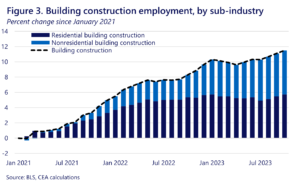US Economy and Labor Unions
TL/DR -
The U.S. Treasury Department has released a report on labor unions, demonstrating their potential to enhance the economy and strengthen the middle class by raising income, enhancing work environments, and increasing job satisfaction. The report showed that union membership and income inequality have diverged over the past century, with union membership peaking in the 1950s and steadily declining thereafter, while income inequality has been on the rise. Furthermore, the report highlighted that unions can also address other negative economic trends including stagnating wages and rising income volatility experienced by middle-class households, and can help to make the economy more equitable.
Treasury Department Highlights Labor Union's Role in Strengthening Economy
The Treasury Department recently issued a first-ever report on labor unions, underscoring the ways they bolster the middle class and stimulate the broader economy. Historically, unions have served to counterbalance wage stagnation, income instability, and decreased intergenerational mobility experienced by middle-class households, despite overall economic growth. Pro-union policy stands to help middle-class households by increasing their incomes, enhancing work conditions, and improving job satisfaction. In doing so, unions contribute to a more balanced and vigorous economy.
Union membership rates and income inequality have moved in opposite directions over the past century. Union membership spiked to one-third of the workforce in the 1950s, a time when income inequality was near its lowest point since the Great Depression and continued to decline. However, union membership has gradually fallen over subsequent decades, while income inequality started to rise after bottoming out in the 1970s. By 2022, union membership had stabilized at 10 percent of workers, even as the top one percent of income earners took home almost 20 percent of total income.
Unions' Potential to Offset Economical Challenges
The Treasury's report suggests that unions can help mitigate some negative trends by increasing middle-class wages, enhancing work environments, and promoting demographic equality. Unions may not be the sole solution to these issues, but the evidence indicates they can play a vital role in building a strong middle-class economy.
One major benefit of union membership is the "union wage premium," i.e., the additional income that union members earn compared to non-members. Simple comparisons show that union workers generally earn about 20 percent more than their non-union counterparts. After controlling for numerous worker and occupation characteristics, the union wage premium is estimated to be around 10 to 15 percent, with larger effects for long-term workers.
Unions Improve Work Environments and Promote Workplace Equality
Unions considerably enhance workers' wellbeing through non-wage benefits like healthcare and retirement benefits, and intangible aspects like flexible scheduling or workplace safety. Unions play a vital role in improving work environments, thereby enhancing workers' wellbeing and that of their families.
Unions also foster workplace equality. Today, union membership is roughly equal among men and women, and promotes anti-discrimination measures, supports anti-discrimination legislation and enforcement, and advances wage-setting practices that are less prone to implicit bias. Empirical studies confirm that unions have succeeded in reducing race and gender wage gaps within firms.
Unions' Positive Spillover Effects
Unions' positive impacts extend beyond their members. Non-unionized firms competing with unionized ones may opt to increase wages, alter hiring practices, or enhance the workplace environment to attract workers. Unions can also influence workplace norms by advocating for safety improvements or changes in minimum wage laws. These collective actions yield significant benefits for communities, enhancing social capital and civic engagement.
The Biden-Harris administration recognizes unions' contributions to the middle class and the broader economy and has taken steps to empower workers. Union petitions in 2022 increased to their highest level since 2015, and public support for unions is at its highest in over 50 years. The evidence suggests that these emerging signs of worker empowerment are positive developments for the middle class and the overall economy.
---
Read More USA Works News


